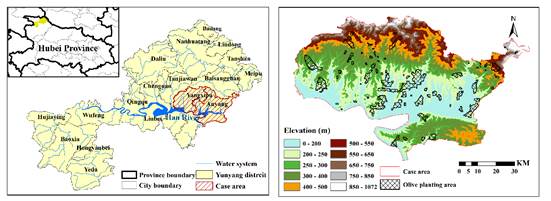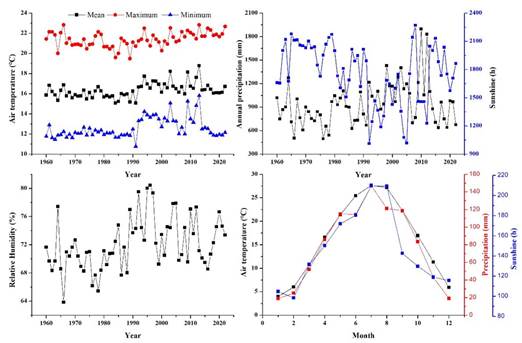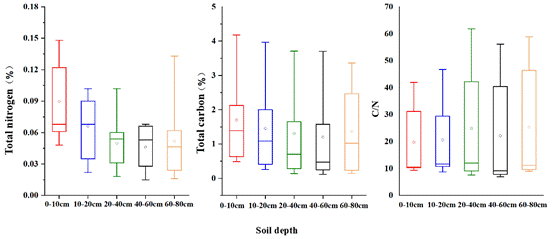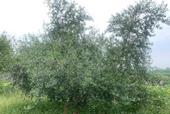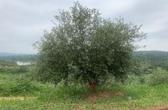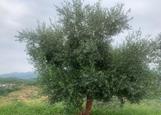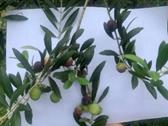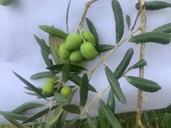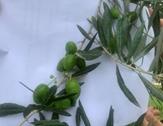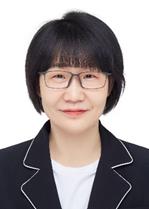Yunyang Olive in Subtropical Low Mountain and Hilly Area
Abstract
Yunyang Olive is planted in the subtropical low mountain and hilly area of the Hanjiang Valley in Anyang and Yangxipu Towns of Yunyang District, Shiyan City, Hubei Province of China, with a core area of 2,060 ha. The case area has average annual temperature of 16℃, annual sunshine duration of 1,768 hours, and annual precipitation of 939 mm. The soil is predominantly calcareous gravelly yellow-brown soil, with heavy metal content remains far below the national standard of GB15618—2018, and the area is free from soil environmental pollution. As a designated conservation area within China’s South-to-North Water Diversion Project, the irrigation water meeting national standard for drinking water quality (GB 5749-2022). The case area is one of China’s four pioneering experimental zone for olive introduction and cultivation since 1964, and a set of olive cultivation practices adapted to the local climatic conditions has been developed. This case proposes a new model of core water source area protection and sustainable development of Yuyang olives, covering their ecological and geographical environment, cultivated varieties, product development, and industrial advancement. The dataset includes: (1) case study area; (2) physical geographical data; (3) olive variety characteristics data; (4) management, economic and historical cultural tradition data. The dataset is archived in .shp, .tif, .xlsx, .jpg, .txt and .doc data formats, and consists of 86 data files with data size of 168 MB (compressed into one file with 89.1 MB).
Introduction
As a country with a large population, China faces significant challenges in maintaining a long-term balance between the supply and demand of grain and oil products. China's dependence on imported vegetable oils remains high. In 2021, China imported over 10 million tons of edible vegetable oil, with an external dependence rate approaching 70% [1]. Against this backdrop, the olive (Olea europaea L.), the world’s only woody oil crop that produces edible oil directly from cold-pressed fresh fruit, has gained increasing strategic value. Olive oil, which is rich in unsaturated fatty acids, phenolic compounds, squalene, vitamins, and other beneficial components, is known for its health benefits, including the prevention of cardiovascular diseases, anti-cancer properties, and anti-aging effects [2]. It has thus earned the reputation of being “liquid gold”. According to the China Customs Statistics Yearbook, China imported 330 tons of olive oil in 2000, 24,700 tons in 2010, approximately 35,000 tons in 2011, and up to 45,000 tons in 2022. However, domestically produced olive oil accounted for only 11.1% of the total imports [3]. Since the 1960s, China has initiated the introduction and cultivation of olive trees. By 1980, in the early stage of olive tree introduction, approximately 23 million trees had been planted across 16 southern provinces [4, 5]. Since the 21st century, the olive industry in China has developed rapidly, characterized by regional planning, large-scale operations, and high-quality production [6]. By 2011, the total cultivated area of olive trees in China had reached about 30,000 hectares [5]. In 2012, the national output of fresh olives surpassed 10,000 tons, and by 2017, it had increased to 61,900 tons, with an average annual growth rate of 43.7% [7]. With the gradual improvement of the deep-processing industry for olives, more than 50 high value-added products in eight major categories have been developed, covering olive fruit, oil, leaf extracts, and more.
With rising living standards, enhanced health awareness, and dietary restructuring, consumers are increasingly concerned about healthy eating, particularly the safety and health benefits of edible oils. Specialty oil crops have become high-value agricultural products with significant commercial value, gaining strong preference among growers and agribusinesses. Their critical role in alleviating supply-demand imbalances in edible oils, safeguarding national grain and oil security, and improving consumption quality is now widely recognized. Yunyang District of Shiyan City, Hubei province, located in the transitional zone between the eastern extension of the Qinba Mountains and the upper-middle reaches of the Han River, lies within the core water source area of China’s South-to-North Water Diversion Project. In 1964, Yunyang District, as the only trial planting area for olive trees in northwestern Hubei, planted 106 olive saplings introduced from Albania by Premier Zhou Enlai. Thanks to government support and active participation from local farmers, the olive cultivation area in Yunyang reached 53.33 km²by 2024, making it one of China's key olive planting and olive oil production bases. This paper compiles ecological environment information for olive production in Yunyang District, Shiyan City. Serving as a case study on the conservation and sustainable development of low mountain and hilly area in the northern subtropical zone, the study aims to protect the reputation of Yunyang olives, enhance their brand value, and further expand their commercial potential and consumer base.
Metadata of the Dataset
The metadata of the dataset “GIES Case Dataset on Yunyang Olive in Subtropical Low Mountain and Hilly Area” [8] is presented in Table 1.
Table1 Summary of Metadata for the GIES Case Dataset on Yunyang Olive in Subtropical Low Mountain and Hilly Area [8]
| Items | Description |
|---|---|
| Dataset full name | GIES Case Dataset on Yunyang Olive in Subtropical Low Mountain and Hilly Area |
| Dataset short name | YunyangOliveCase25 |
| Authors | Hu, S., Institute of Geographic Science and Natural Resources Research,Chinese Academy of Science, hus.08b@igsnrr.ac.cn |
| Xiao, B. W., Yunyang Municipality, yunyang@shiyan.gov.cn | |
| Lei, M. Y., Yunyang Municipality, yunyang@shiyan.gov.cn | |
| Ye, B., Anyang Town, yebao23@163.com | |
| Qin, B., Yangxipu Town, qinbo91@163.com | |
| Chen, T., Yunyang Development and Reform Commission, 422926851@qq.com | |
| Han, S. B., Yunyang Forest Bureau, hanshibin@163.com | |
| Wang, X. L., Yunyang Agriculture and Rural Affairs Bureau, wangxianlin@163.com | |
| Wang, Z. S., Research Institute of Forestry Chinese Academy of Forestry, w@caf.ac.cn | |
| Wu, Y., Wuhan Polytechnic University, wuyan23@163.com | |
| Wang, H. T., Research Institute of Forestry Science in Yunyang District, hushiqiang@163.com | |
| Hu, S. Q., Yunyang Olive Industrial Chain Office, hushiqiang@163.com | |
| Yu, X. W., Yunyang Olive Industrial Chain Office, 335392247@qq.com | |
| Liu, X. L., Yunyang Olive Industrial Chain Office, 232349509@qq.com | |
| Zhu, J. Y., Xinlanyuan Olive Technology Co., Ltd., 8811487@qq.com | |
| Wang, J. H., Zemeng Agricultural Development Co., Ltd., 1336846274@qq.com | |
| Xie, Y. B., Xinlanyuan Olive Technology Co., Ltd., 5025973@qq.com Zhang, L., Zemeng Agricultural Development Co., Ltd., zl19840603@163.com Zhao, Y. M., Hubei Provincial Olive Industrial Technology Research Institute, zhaoxiaoyi00@vip.qq.com | |
| Liu, Z. H., Institute of Geographic Science and Natural Resources Research,Chinese Academy of Science, liuzihan22@mails.ucas.ac.cn | |
| Yuan, W. R., Institute of Geographic Science and Natural Resources Research,Chinese Academy of Science, yuanwenrui24@mails.ucas.ac.cn | |
| Geographical region | Anyang township and Yangxipu township, Yunyang District, Shiyan City, Hubei province |
| Data Format | .shp, .tif, .xlsx, .jpg, .txt, .doc |
| Data Size | 168 MB |
| Data files | Four sub-datasets: (1) case study area; (2) physical geographical data; (3) olive variety characteristics data; (4) management, economic and historical cultural tradition data |
| Data publisher | Global Change Scientific Research Data Publishing System http://www.geodoi.ac.cn |
| Address | No. 11A, Datun Road, Chaoyang District, Beijing 100101, China |
| Data sharing policy | Data from the Global Change Research Data Publishing & Repository includes metadata, datasets (in the Digital Journal of Global Change Data Repository), and publications (in the Journal of Global Change Data & Discovery). Data sharing policy includes: (1) Data are openly available and can be free downloaded via the Internet; (2) End users are encouraged to use Data subject to citation; (3) Users, who are by definition also value-added service providers, are welcome to redistribute Data subject to written permission from the GCdataPR Editorial Office and the issuance of a Data redistribution license; and (4) If Data are used to compile new datasets, the ‘ten percent principal’ should be followed such that Data records utilized should not surpass 10% of the new dataset contents, while sources should be clearly noted in suitable places in the new dataset[9] |
| Communication and searchable system | DOI,CSTR,Crossref,DCI,CSCD,CNKI,SciEngine,WDS/ISC,GEOSS |
Description of the Yunyang Olive Case
Physical Geographic Data
Description of the Case Area
Yunyang District of Shiyan City (32°25′N-33°16′N, 110°07′E-111°16′E) is located in northwestern Hubei Province, at the junction of four provinces: Hubei, Henan, Shaanxi, and Chongqing. The district borders Henan Province to the northeast, and Baihe and Shangnan counties of Shaanxi Province to the west and north, respectively. Yunyang District comprises 19 townships and one economic development zone (Figure 1), with a total area of 3,836 km². As the core water source area of the South-to-North Water Diversion Project’s Middle Route, Yunyang has a water area of 146.08 km² in the Han River, accounting for 14% of the total area of the Danjiangkou Reservoir and 19% of its shoreline (821.11 km). Yunyang District is hailed as “the Great Well of the South-to-North Water Diversion Project, the Eternal Land of Yunyang”. Anyang Town and Yangxipu Town, which located in the Han River valley, were selected as the case study area. Anyang Town, with an area of 207.8 km2 and jurisdiction over 23 administrative villages, is a traditional olive-growing area in Yunyang. Adjacent to Anyang, Yangxipu Town covers an administrative area of 130 km2 and governs 16 administrative villages. As of 2024, the olive cultivation areas in Anyang and Yangxipu reached 14.67 km2 and 5.93 km2, respectively.
Meteorological Characteristics
Situated in the Han River Basin of the Qinling-Daba Mountains, Yunyang District exhibits a unique climatic pattern integrating North Subtropical Continental Monsoon and localized microclimates. This results from a complex terrain-hydrology system where: the Qinling Mountains to the north create a significant barrier effect against cold air masses from the northwest; the Daba Mountains to the south disrupt and intercept warm-moist currents from the southwest through orographic uplift; and the Danjiangkou Reservoir modulates regional microclimates via its massive storage capacity.
From 1960 to 2024, the average annual temperature in the case area was 16 ℃, with mean maximum and minimum temperatures of 21.4 ℃ and 12.6 ℃, respectively (Figure 2). The annual temperature range was 23.6 ℃, and the accumulated temperature above 10 ℃ was 5139.3 ℃. Unlike the Mediterranean climate of olive’s origin, which is characterized by hot, dry summers and warm, moist winters, the case area is characterized by hot and rainy summer. The average daily temperature in the hottest month reaches 27.6 ℃. The annual precipitation is 939.86 mm, with approximately 114 rainy days per year. Notably, 61.6% of the total annual precipitation occurs between May and September, which coincides with the peak growing period for olive trees. Winters in Yunyang are cold and dry, with January being the coldest month, averaging 4.0 ℃. Precipitation during winter (December to February) accounts for only 6.72% of the annual total. The region also enjoys abundant sunlight, with an average of 1,768 sunshine hours per year and an average sunshine percentage of 45.0%. The frost-free period lasts approximately 247 days annually.
Topographic Characteristics and Ecological Environment
Yunyang District lies in the gently folded and sloping zone formed by the eastern branches of the Qinba Mountains, in the lower reaches of the upper Han River basin. The transitional zone between the northern and southern parts of Yunyang consists of medium-low mountainous areas above 800 m above sea level, while the central Han River valley forms a transitional belt of river valley plains at 250~500 m elevation. The total forest land in Yunyang is approximately 2.95 million hectares, with a forest coverage rate of 61%. Among this, 68% of the forested land is distributed below 800 meters in elevation, primarily in the low mountain and hilly zones surrounding the Danjiangkou Reservoir and along the gentle slopes of the Du River. Furthermore, 76% of the forested land has a slope of less than 25°, providing favorable topographic conditions for forestry development. Anyang Town and Yangxipu Town are located in the Han River valley, with elevation ranges from 0 to 1,072 meters, in with 87.8% of the land lying below 550 meters (Figure 1). The slope ranges from 0°to 67°, and 89% of the area has slopes under 25°(Figure 3). Land use in the case area is dominated by forest, grassland, and farmland. According to Sentinel-2 satellite imagery from 2024, these land types account for 43.71%, 11.18%, and 34.39% of the total area, respectively (Figure 4). A time-series analysis using Sentinel-2 remote sensing data from 2000 to 2018 reveals a general improvement in vegetation conditions in Anyang and Yangxipu. Areas showing an increasing trend in NDVI account for as much as 92% of the total, indicating a significant enhancement in the overall ecological environment of the case area (Figure 5).
| Figure 5Maps of vegetation greenness in the case area (a is NDVI in July 2023, b is NDVI annual change trend from 2000 to 2023) |
|---|
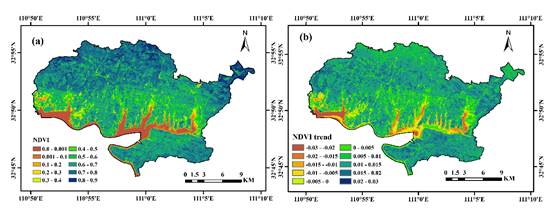
|
3.1.4 Soil Physicochemical Properties
The core olive cultivation areas in Yunyang District are dominated by calcareous sandy yellow-brown soils with moderately low fertility. Soil pH in the district ranges from 5.0 to 8.8, with an average of 7.2. Approximately 94% of the sampled plots have pH values between 5.5 and 8.5, which falls within the optimal pH range for olive growth. The average organic matter content in the soil is 1.6%, and the mean alkali-hydrolyzable nitrogen content is 76.27 mg/kg. Only 21.9% of the plots have nitrogen levels above 100 mg/kg (Nitrogen-sufficient status), while 60.4% fall between 50 and 100 mg/kg. According to the Second National Soil Survey of China, slope sampling point in the case area are predominantly calcareous purple clay or calcareous purple gravel soils. Their organic matter content ranges from 6.7% to 31.3%, alkali-hydrolyzable nitrogen from 29.8 to106.4 mg/kg, available phosphorus from 27.5 to 34.4 mg/kg, and available potassium from 7.5 to 34.4 mg/kg. In 2022, the exchangeable calcium content in the Dongfang Olive Orchard in Yangxipu Town ranged from 3,989 to 4,485 mg/kg. In May 2024, a total of 44 soil samples at various depths were collected from nine sampling sites across the case area. Total nitrogen (TN, %), total carbon (TC, %), carbon-to-nitrogen ratio (C/N), pH, and heavy metal content of these samples were analyzed at the Physical and Chemical Analysis Center of the Institute of Geographic Sciences and Natural Resources Research, Chinese Academy of Sciences. Results showed that soil pH values ranged from 6.17 to 7.50 across different soil layers, with an average pH of 7.05, indicating neutral soil conditions. Total nitrogen (TN) ranged from 0.015% to 0.233%, with an average of 0.06%; total carbon (TC) ranged from 0.118% to 4.178%, with an average of 1.43%; and the average carbon-to-nitrogen ratio (C/N) was 22.46, with values ranging from 6.90 to 61.86. Both TN and TC contents, as well as the C/N ratio, showed a clear surface enrichment pattern, with values decreasing progressively with soil depth (Figure 6).
The results of the heavy metal analysis of soil samples from the case area, along with the 2022 soil pollutant test results from Yangxipu Town, show that the contents of eight heavy metals, chromium (Cr), nickel (Ni), copper (Cu), zinc (Zn), cadmium (Cd), lead (Pb), mercury (Hg), and arsenic (As), were significantly lower than the risk screening values stipulated in both the “Pollution-free food - Environmental conditions for fruit (NY 5013-2006)” [10] and the “Soil environmental quality risk control standard for soil contamination of agricultural land (Trial) (GB 15618-2018)” [11] (Table 3). No residues of organochlorine pesticides such as hexachlorocyclohexane (BHC) and dichlorodiphenyltrichloroethane (DDT) were detected in the soil (Table 4), conforming to the risk screening values for “other items” stipulated in the “Soil environmental quality risk control standard for soil contamination of agricultural land (Trial) (GB 15618-2018)” [11] (both BHC and DDT limits are 0.1 mg/kg).
Table 3 Soil heavy metal content in the case area (unit: mg/kg)
| Test items | Limit value | Mean | Range |
|---|---|---|---|
| Cr | ≤200[1, 2] | 96.67 | 73.85~114.37 |
| Ni | ≤100[1] | 46.51 | 33.10~64.36 |
| Cu | ≤200[1] | 36.17 | 22.41~50.03 |
| Zn | ≤250[1] | 127.31 | 108.24~153.89 |
| Cd | ≤0.3[1,2] | 0.06 | 0.00~0.19 |
| Pb | ≤120[1],300[2] | 15.67 | 0.00~33.26 |
| Hg | ≤2.4[1],0.3[2] | 0.0122 | 0.00~0.1050 |
| As | ≤30[1, 2] | 5.69 | 0.00~22.03 |
Note: [1] Soil environmental quality risk control standard for soil contamination of agricultural land (Trial) (GB 15618–2018), [2] Pollution-free food - Environmental conditions for fruit (NY 5013–2006)
Table 4 Soil Heavy Metal content and residues of organochlorine pesticides in Dongfang Olive Orchard, Yangxipu Town (2022, unit: mg/kg)
| Test items | Limit value | Results | Test items | Limit value | Results | ||
|---|---|---|---|---|---|---|---|
| Cr | ≤200 | 43 | Pb | ≤120 | 21 | ||
| Ni | ≤100 | 13 | Hg | ≤2.4 | 0.0281 | ||
| Cu | ≤100 | 17 | As | ≤30 | 4.82 | ||
| Zn | ≤250 | 99 | BHC | ≤0.1 | ND | ||
| Cd | ≤0.3 | 0.15 | DDT | ≤0.1 | ND | ||
Note: ND = Not Detected; limit values are based on the Soil environmental quality risk control standard for soil contamination of agricultural land (Trial) (GB 15618-2018).
3.1.5 Water Quantity and Quality
Yunyang District contains a total of 766 rivers and streams, with a combined length of 3,351 kilometers. Major rivers include the Han River, Tao River, Du River, Quyuan River, and Jiangjun River (Figure 1). The average runoff is 263.4 mm, with an average annual water production modulus of 2.63×105 m3/km². The multi-year average surface water resources amount is 1.017×109 m³, and groundwater resources amount is 4.12×108 m³.The district receives abundant transit water, with an average annual inflow of 3.3111×109 m³. This inflow mainly originates from the Han River (82%, 2.7141×109 m³), Du River (5.86×108 m³), and Tao River (1.1×107 m³). The annual outflow reaches 3.4420×109 m³, with the Han River (including the Du River) accounting for 98.6% (3.3950×109 m³) and the Tao River 1.4% (4.7×107 m³). Although olive trees prefer drought conditions and are sensitive to waterlogging, their water needs mainly depend on precipitation. Nevertheless, the abundant water resources in the region can effectively supplement the water demand during dry seasons.
As a core water source area of the South-to-North Water Diversion Project, water quality at eight national and provincial monitoring sections in Yunyang District has consistently maintained at or above Class III standards, with 5 key sections sustaining long-term compliance with Class II standards for high-quality water bodies. In May 2024, six sampling sites were established in the case area, where river and irrigation water samples were collected. These samples were analyzed at the Physical and Chemical Analysis Center of the Institute of Geographic Sciences and Natural Resources Research, Chinese Academy of Sciences, for elements including aluminum (Al), mercury (Hg), arsenic (As), cadmium (Cd) and so on, as well as pH levels. The results (Table 5) indicate that sample pH values ranged from 6.59 to 7.67. All samples showed mercury, arsenic, cadmium and other measured elements levels not only significantly lower than the limits stipulated in the “Standards for Irrigation Water Quality (GB 5084-2021)” [12], but also fully compliant with the “Standards for Drinking Water Quality (GB 5749-2022)” [13].
Table 5 Water quality data in the case area
| Test Item | Mean | Range | Unit | Limit Value |
|---|---|---|---|---|
| Al | 0.0232 | 0~0.0712 | mg/L | 0.2[2] |
| Hg | 0.0000 | 0.000 | mg/L | 0.001[2],1[1] |
| B | 0.0070 | 0~0.213 | mg/L | 1[1,2] |
| Fe | 0.0016 | 0~0.0049 | mg/L | 0.3[2] |
| Na | 6.4453 | 4.114~8.492 | mg/L | - |
 |
27.6700 | 14.22~39.54 | mg/L | 250[2] |
| As | 1.6351 | 0~4.3 | ug/L | 10[2],100[1] |
| Ba | 16.9833 | 0~35.8 | ug/L | 700[2] |
| Cd | 0.0000 | 0 | ug/L | 5[2],10[1] |
| Cr | 0.0500 | 0~0.2 | ug/L | 50[2],100[1] |
| Cu | 0.1833 | 0~0.6 | ug/L | 1000[1,2] |
| Mn | 0.4316 | 0.04~0.9 | ug/L | 100[2] |
| Ni | 1.2333 | 0~2.5 | ug/L | 20[2],200[1] |
| Pb | 0.0000 | 0 | ug/L | 10[2],200[1] |
| Se | 9.7833 | 0~22 | ug/L | 10[2],20[1] |
| Zn | 5.3500 | 1.7~10.2 | ug/L | 1000[2],2000[1] |
| Mo | 4.2833 | 0~12.3 | ug/L | 70[2] |
| Li | 0.0065 | 0~0.0112 | mg/L | - |
| Ca | 27.4517 | 11.77~42.47 | mg/L | - |
| K | 1.1407 | 0.8286~1.444 | mg/L | - |
| Mg | 13.3110 | 9.136~18.44 | mg/L | - |
| P | 0.0033 | 0~0.0127 | mg/L | - |
| Sr | 0.0537 | 0~0.1342 | mg/L | - |
| SiO2 | 1.0252 | 0.3738~1.364 | mg/L | - |
| Co | 0.0667 | 0~0.3000 | ug/L | - |
Note:[1] Standards for Irrigation Water Quality (GB 5084-2021), [2] National Drinking Water Quality Standard (GB 5749-2022)
Characteristics of Olive
Olive Varieties
Olive (Olea europaea L.) is an evergreen economic tree species belonging to the genus Olea in the family Oleaceae. It is one of the world's four major woody oil crops. Originating from the Mediterranean region, olive trees are now cultivated in dozens of countries and regions worldwide. Yunyang District is located within the secondary suitable cultivation zone for olive in the middle and lower Yangtze River basin [14]. The main varieties include Arbequina, Miracle, Arbosana, Ezhi No. 8, Picual, and Picholine. Among them, Picual, Picholine, and Arbequina occupy a large planting area (Figure 7).
Variety 1: Arbequina. Also known as Abiquina or Abekina, Arbequina is an internationally recognized olive variety characterized by early fruiting, stable yields, and high productivity. This variety has a high self-pollination rate, with fruit ripening relatively early in late October. The dry fruit oil content reaches 48.04%, and fresh fruit oil content is 26.46%, producing a mildly flavored olive oil. Arbequina has strong stress resistance, including cold tolerance, salt-alkali tolerance, high humidity resistance, and resistance to olive leaf spot and olive knot diseases. However, this variety is highly sensitive to soil calcium and grows poorly in acidic or calcium-deficient soils.
Variety 2: Picual. Picual is a world-famous olive variety known for its high oleic acid content. It has strong early fruiting characteristics, typically flowering and fruiting around five years after planting. Picual can self-pollinate with a high fruit set rate. Its fruit matures relatively late, generally in mid to late November. Dry fruit oil content ranges from 42.78% to 43.20%, while fresh fruit oil content ranges from 20.63% to 23.81%, producing a robustly flavored olive oil. Picual demonstrates remarkable cold resistance (tolerant to temperatures as low as -10 ℃), salt-alkali tolerance, and flood tolerance but is sensitive to drought. High temperature and humidity in summer can cause leaf drop. It is resistant to olive knot and olive anthracnose diseases.
Variety 3: Picholine. Originally from France, Picholine is a dual-purpose variety used for both oil and table olives. It has a low self-fruit set rate, but fruit set can be significantly improved through cross-pollination, with a notable alternate bearing pattern. The dry fruit oil content ranges from 34.1% to 43.27%, and fresh fruit oil content ranges from 18% to 20%, producing a robustly flavored olive oil. Picholine is highly adaptable to various environments, preferring sunny and drought conditions. It has strong cold tolerance, is resistant to poor soils, favors calcareous soils, but is sensitive to waterlogging and soils with poor permeability. Additionally, it shows high resistance to Peacock Spot disease.
Quality of Yunyang Olive
Quality assessment data of Yunyang olives indicate that oleic acid (monounsaturated fatty acid) contents in three main cultivars (Picual, Picholine, and Arbequina) reaches 64.53~77.74%, while the linoleic acid (polyunsaturated fatty acid) content ranges from 3.32% to 12.20% (Table 6). Monounsaturated fatty acids play a role in regulating low-density lipoprotein (LDL) cholesterol metabolism, while linoleic acid, an essential fatty acid for humans, is involved in cell membrane construction and immune regulation [15]. These factors largely explain the lipid-regulating and immune-modulating functions of olive oil. Laboratory analysis of olive oil, the primary product of olive fruit, indicates a polyphenol content of 273.00 mg/kg and a monounsaturated fatty acid content of 75.7 g/100g. Meanwhile, the polyphenol content in commercially available domestic extra virgin olive oils ranges from 63.885 to 307.325 mg/kg [16].
Table 6 Quality Data of Olive (unit: %)
| Picual | Picholine | Arbequina | ||||
|---|---|---|---|---|---|---|
| Mean | Range | Mean | Range | Mean | Range | |
| Oleic acid (C18:1n9c) | 76.37 | 75.9~77.0 | 77.47 | 77.1~77.8 | 64.53 | 63.4~65.4 |
| Linoleic acid (C18:2n6c) | 5.88 | 5.56~6.13 | 3.32 | 3.12~3.54 | 12.20 | 11.8~12.8 |
| α-linolenic acid (C18:3n3) | 0.989 | 0.967~1.01 | 0.884 | 0.865~0.894 | 0.921 | 0.916~0.926 |
| Palmitic acid (C16:0) | 12.90 | 12.7~13.1 | 13.60 | 13.5~13.7 | 17.07 | 16.8~17.4 |
| Palmitoleic acid (C16:1) | 1.31 | 1.23~1.40 | 2.04 | 2.00~2.06 | 2.84 | 2.65~3.02 |
| Stearic acid (C18:0) | 1.77 | 1.74~1.80 | 2.09 | 2.06~2.11 | 1.74 | 1.71~1.77 |
| Arachidic acid (C20:0) | 0.390 | 0.383~0.395 | 0.349 | 0.347~0.351 | 0.386 | 0.380~0.391 |
Laboratory analysis of olive oil from the case area revealed no detectable levels of heavy metals (including total arsenic and lead), fully compliant with National food safety standard - edible vegetable oil (GB 2762-2018) [17]. Additionally, no residues from 375 pesticides (e.g., chlorpyrifos and trichlorfon) were detected, meeting the requirements of National Food Safety Standard -Maximum Residue Limits for Pesticides in Food (GB 2763-2021) [18].
Management of the Olive Industry
Yunyang's olive industry has established a modern full-industry-chain model, centered on three core systems: an independent seedling propagation system, a standardized cultivation base, and an intensive processing system.
Partner Enterprise: Hubei Xinlanyuan Olive Technology Co., Ltd.
Hubei Xinlanyuan Olive Technology Co., Ltd., established in June 2015, is the first nationally recognized integrated demonstration park in China that combines ecological agriculture, health food production, biotechnology, and agri-cultural wellness tourism within the olive industry. The company has developed a comprehensive industrial system encompassing primary, secondary, and tertiary sectors. In the primary sector, it manages over 3.33 km2 of self-owned olive plantations through ecological cultivation practices. In the secondary sector, it has constructed China’s first 10,000-square-meter digitalized olive deep-processing plant, which also includes a dedicated cosmetics manufacturing facility. In the tertiary sector, it has pioneered a multifunctional development model integrating industry with culture, health care, educational tourism, and rural lodging, exemplified by the establishment of Dongfang Olive Garden-a site recognized as both a national AAA-level tourist attraction and a national forest wellness base. The company has been designated a National Key Leading Enterprise for Agricultural Industrialization and a National Key Forestry Leading Enterprise. It also participated in drafting China’s new national standards for olive oil and has been certified as a National High-Tech Enterprise. Furthermore, it has received multiple honors from the Hubei Grain Industry Association, such as “Jingchu Premium Grain and Oil”, “Top Five Specialty Oils”, and “Leading Enterprise in Hubei’s Grain Industry”. For three consecutive years, it has been recognized as a provincial model enterprise under the “Ten Thousand Enterprises Assist Ten Thousand Villages” initiative. In 2025, it was awarded the “Organic Gold Medal” at the China International Olive Oil Competition.
Partner Enterprise2: Shiyan Zemeng Agricultural Development Co., Ltd.
Shiyan Zemeng Agricultural Development Co., Ltd., established in 2017, has invested 500 million RMB to develop the Anyang Lake Olive Industrial Park. At present, the company has established a high-standard olive plantation covering nearly 3.33 km2, with more than 130,000 olive trees cultivated. It has registered the trademarks “Anyang Lake” and “Olive Dream Workshop”. The company holds 17 authorized patents, including 2 invention patents. Adhering to the mission of revitalizing the domestic olive oil industry and promoting regional economic development, the company has focused on the Olive Dream Workshop project, aiming to build a premium, fresh, extra virgin olive oil brand representative of China’s high-end market.
Olive Cultivation and Management
The olive tree (Olea europaea L.), characterized by drought tolerance, photophilous nature, cold sensitivity, and waterlogging intolerance, thrives in alkaline sandy soils. Large-scale introduction of this species in China has occurred only within the past six decades. Yunyang District has pioneered the “Yunyang Model”, a localized cultivation system tailored to its unique climatic and edaphic conditions, by integrating the species’ biological traits with regional environmental adaptations.
(1) Establish a Seedling Breeding System
Vigorously promote the Picual, Picholine, and Arbequina. Picual and Picholine, are globally renowned oil-purpose cultivars, characterized by high oil content, superior oil quality, strong waterlogging resistance, and excellent freezing resistance. Arbequina is a widely cultivated variety worldwide, known for its high and stable yield. To enhance frost resistance, high-altitude areas should be supplemented with freezing-resistant varieties such as Leccino, Low-altitude areas should be supplemented with oil-quality-focused varieties like Frantoio.
(2) Soil-Ridge Cultivation Model
Prior to 2021, farmers in Yunyang District predominantly adopted the “pit planting” method, which led to excessive soil moisture causing root rot, soil compaction inducing root suffocation, and consequently failure in flowering/fruiting along with high mortality rates in olive trees. Based on Yunyang’s specific soil structure and rainfall patterns, in 2021, Deng Mingquan, China’s chief olive cultivation expert, proposed a comprehensive approach-trench digging, soil replacement, deep tillage, and ridge cultivation. This method has now evolved into the widely promoted “Soil-Ridge Cultivation Model” in Yunyang. Its advantages include: enhanced drainage and waterlogging prevention, improved soil aeration and oxygenation, accelerated root system development, prevention of root rot and suffocation, optimized soil aggregate structure, and increased soil organic matter content.
Site Selection and Preparation: Select south-facing slopes with wind-sheltered and sunny conditions, featuring well-drained and aerated soil. Clear the afforestation area of large gravel (>5 cm diameter), tree roots, shrubs, and peripheral weeds.
Seedling Selection: Use 2-year-old cutting or grafted seedlings of Grade II or above, with a minimum height of 90~110 cm and a ground diameter of no less than 1.0~1.2 cm. Recommended planting density is 20~30 trees per mu (about 133~200 plants/ha), with row and plant spacing ranging from 4 to 7 meters.
Soil-Ridge Cultivation Techniques: The model includes various configurations based on terrain and hydrological conditions:
①High-Wide Ridge Cultivation: For flat and open field, adopt the whole-field deep tillage method for ridge formation, with a ridge base width ≥4 m, ridge top width ≥2.5 m, and ridge height adjusted to 60~80 cm depending on drainage capacity. The bottom layer of each planting hole should be configured with nutrient soil at a soil-to-manure ratio of 6:4.
②Trench Digging, Backfilling, and Ridge Cultivation: For gentle slopes and terraced fields, adopt a method of digging trenches, backfilling with organic matter, and forming ridges. Key specifications include: trenches width ≥2 m, trench depth >60 cm, and ridge height ≥50 cm. Complemented by internal drainage ditches to ensure unimpeded drainage during rainy seasons.
③Monolithic Mounded Soil Planting: For small or irregularly shaped terrains unsuitable for conventional ridge cultivation, adopt the monolithic mounded soil planting method. Key steps include: collecting topsoil, thoroughly mixing with organic manure at a soil-to-manure ratio of 6:4, designing a trapezoidal cross-section with base width of 2.5 m, operating surface width of 1.5 m, and vertical height of 60 cm.
④“凸”-Shaped Cultivation (Convex-Shaped Cultivation): For areas with high groundwater levels or seasonal waterlogging, adopt a combined model of high-wide ridges and monolithic mounds, colloquially termed "convex-shaped cultivation". This system ensures healthy capillary root development and prevents root rot.
(3) Management
“Only 10% is about planting, the remaining 90% lies in management” for olive cultivation. Yunyang District has enacted the “Technical Guidelines for Year-Round Maintenance of Newly Planted Olive Seedlings”, establishing a scientific management system covering weeding, pest and disease control, fertilization, and soil conservation.
Soil Management: After fruit harvesting each autumn or winter, trench expansion (30~40 cm deep, 30~40 cm wide) must be performed around the periphery of the original planting pit or the crown drip line. Additionally, inter-canopy weeding and soil loosening should be conducted 2~3 times annually within the tree crown area. Operation zone is 20~30 cm from the trunk base, loosening depth should not exceed 5 cm for young trees and should be controlled within 10~20 cm for mature trees.
Fertilization: Basal fertilization primarily consists of fully decomposed organic manure. Supplemental fertilization focuses on nitrogen, phosphorus, and potassium (Table 7), with additional calcium and boron applied as needed. Fertilization is performed 2~3 times annually: before bud break, one month prior to flowering, and during fruit development. Application methods include whole-orchard broadcasting, Circular trench fertilization, and Radial furrow application.
Table 7 Fertilizer Application Rates for Olive Trees (unit: kg/tree)
| Young Trees | Early Fruiting Trees | Full Fruiting Trees | |||
|---|---|---|---|---|---|
| Basal Fertilizer | 10~20 | 30~50 | 50~100 | ||
| Supplementary Fertilization | Nitrogen:0.1~0.2 | Nitrogen:0.25~0.5 | Nitrogen:1~2 | ||
| Phosphorus:0.3~0.5 | Phosphorus:0.5~1 | Phosphorus:1~2 | |||
| Potassium:0.2~0.3 | Potassium:0.3~0.5 | ||||
Irrigation and Drainage: The timing and frequency of irrigation are determined based on local climatic conditions. Adequate water supply is essential during key phenological stages, including floral bud differentiation, flowering and fruit setting, fruit enlargement, and stone hardening. Supplemental irrigation is necessary during dry periods in winter and spring to maintain optimal soil moisture.
Training and Pruning: Pruning of olive saplings can be conducted during both the growing and dormant seasons, with an emphasis on the latter. Pruning during the growing season should be completed between the emergence of new shoots and the onset of summer. Dormant season pruning is typically carried out after fruit harvest and before bud break in the following spring to improve canopy ventilation and light penetration.
Pest and Disease Management: Olive pest management adheres to the principle of "Prevention First, Integrated Control". Under high-temperature and high-humidity conditions that favor the occurrence of pests such as large-grooved leevil and longhorn beetles, and diseases like anthracnose, it employs low-toxicity, low-residue, and eco-friendly methods. Management practices include the selection of disease-resistant cultivars, appropriate planting density and intercropping, timely orchard sanitation to reduce inoculum sources. During flowering, yellow sticky traps are deployed at a density of 20~40 per mu to monitor and control flying insects. For trunk-boring pests, infested tunnels are cleared using iron wire and treated with a diluted suspension of Beauveria bassiana, or natural predators such as Dastarcus helophoroides are released for biological control. To prevent foliar and anthracnose diseases, Bordeaux mixture (1:2:200) is applied after the emergence of spring shoots and approximately 15 days after fruit set. Chemical pesticides must be discontinued at least 45 days prior to harvest to ensure safety.
(4) Fresh Fruits Time-Limited Picking
Olive oil is extracted through time-constrained cold-pressing of fresh fruits. To ensure the freshness, olives must be manually harvested, subjected to rigorous fruit selection, processed with washing and sterilization, and Pressed within 12 hours post-harvest for oil extraction and storage.
Industrial Operation and Management
Policy Support: The olive industry has been identified as a strategic pillar of Yunyang District's rural revitalization agenda, receiving strong policy support from provincial, municipal, and district levels. At the provincial level, Hubei province has issued key policy documents such as the “Decision on Accelerating the Greening of Jingchu” and the “Implementation Opinions on Deepening Rural Reform and Advancing Rural Revitalization”, which categorize woody oil crops, including olives, as regionally distinctive and advantageous industries and foundational to ecological afforestation and rural prosperity. These documents emphasize the development of the olive industry towards standardized, large-scale, and intensive operations. Shiyan City has incorporated olives into one of its seven major agricultural industrial chains and issued policies such as the “Opinions on Fostering Leading Agricultural Enterprises” to accelerate olive development in Yunyang, Danjiangkou, and Yunxi. At the district level, Yunyang has designated the olive industry as one of its three primary agricultural pillars, with cumulative investments totaling 120 million RMB. Large-scale cultivation has taken shape, and olives have become a significant source of income for residents in the Danjiangkou Reservoir area.
Large-Scale Planting: The Yunyang District has established a comprehensive olive oil industry chain system. By the end of 2024, the cultivation area reached 53.33 km², forming an industrial layout with Anyang and Yangxipu as core production zones, extending to 9 townships including Qingshan, Meipu, Tanshan, Chengguan, Liubei, Wufeng, and Liudong. The district has nurtured 51 market entities, comprising 15 corporate entities, 19 specialized cooperatives, and 17 large-scale growers, including one national-level leading enterprise in agricultural industrialization, one leading forestry enterprise, and five provincial-level leading forestry enterprises. In 2024, the industry benefited 12,000 residents with an average annual income increase of RMB 30,000 yuan per household, achieving a total output value exceeding RMB 450 million yuan.
Deep Integration of Industrial Chains: The Yunyang District established a Party Committee for the Olive Oil Industry Chain, adopting a “Party Committee + Township Governments + Leading Enterprises + Market Entities” model to achieve dual ecological and economic benefits. In 2024, Shiyan City launched the Hubei Institute of Olive Oil Industry Technology through a “Government + Universities + Leading Enterprises” framework, focusing on breakthroughs in key bottlenecks constraining industrial development, such as: land remediation, seedling breeding, cultivation, deep processing, and byproduct utilization. The Hubei Science and Technology Commissioner Workstation provides regular technical training and on-site guidance to enhance farmers' planting skills. The Olive Oil Industrial Alliance, initiated by market entities, implements standardized operations through unified cultivar planting, cultivation protocols, technical services, processing, and regional branding, effectively integrating resources to form an industrial community characterized by “shared experience, interconnected information, complementary functions, and mutual benefits”.
Development History of the Olive Industry
The olive tree (Olea europaea L.), a globally renowned woody oil crop, originated in the Mediterranean region and boasts over 6,000 years. Traditional major producers such as Spain, Italy, and Greece have well-established industrial chains. In 1964, Premier Zhou Enlai introduced 10,680 olive saplings of five varieties: Miza, Frantoio, Elbasan, Kalinjoti, and Bera, from Albania. These were distributed across 12 trial sites in 8 provinces including Yunnan, Sichuan, Guizhou, and Hubei for experimental cultivation. The development of the olive industry in Yunyang District has evolved in tandem with China's national olive introduction journey, undergoing five critical phases:
Introduction and Trial Period: In 1973, the Hubei Academy of Forestry Sciences selected Erwan Forest Farm in Anyang Town, Yunyang District as the sole olive introduction trial zone in northwestern Hubei. After 7 years of cultivation, the trial area achieved first flowering and fruiting. By 1984, the experimental area recorded an average yield of 18.23 kg per plant, with the highest single-plant yield exceeding 82 kg, and an average root diameter of 25 cm, marking the successful introduction and trial of olive trees in Yunyang District. Concurrently, the Yunxian County Forestry Science Institute (now Yunyang District) initiated cutting propagation at Erwan Forest Farm in 1975. Over five years, it cumulatively propagated 120,000 olive seedlings with an average survival rate of 80%. From 1988 to 1993, Deng Mingquan conducted systematic research on high and stable yield techniques in Yunyang, establishing the first high-yield cultivation demonstration orchard. In 1990, French olive cultivation expert Professor Boudier visited Erwan Forest Farm in Wangzhuang Village, Anyang Town to investigate olive planting practices
Decline and Bottleneck Period: By the 1980s, Yunyang District had developed an olive cultivation base of 1.4 million trees covering 6.67 km2. However, following the implementation of the household-based land contracting system, olive planting bases fell into widespread management neglect due to the absence of fresh fruit procurement channels, insignificant economic benefits, and limited public awareness. Compounded by pest infestations and waterlogging disasters, this led to tree mortality and the abandonment of cultivation bases.
Spontaneous Planting Period: In 2006, major growers in Liupi, Meipu, and Tanshan townships spontaneously introduced olive saplings from Longnan, Gansu and Xichang, Sichuan. In 2007, they established the region’s first olive cooperative, “Jinhanjiang Olive Cooperative”, forming a small-scale planting cluster. Subsequently, some enterprises initiated large-scale cultivation, igniting a new wave of olive planting.
Recovery and Development Period: In 2016, Xinlanyuan Olive Technology Co., Ltd. invested RMB 20 million yuan to build China’s first deep-processing plant (10,000 m²). In 2018, it established a 1,700-mu (≈113 ha) standardized olive base using a soil-ridge planting model. The Yunyang District Olive Industry Alliance was established in May. By 2022, the district’s olive industry achieved an initial harvest: fresh fruit output reached 400 metric tons, with a total industrial chain value of RMB 150 million yuan and tax revenue exceeding RMB 4 million yuan.
Leading Development Period: In May 2022, the Yunyang District Committee and Government innovatively established a Party Committee for the Olive Oil Industry Chain, coordinating industrial technology breakthroughs and standardized development. By adopting adaptive cultivation models such as “soil-ridge planting” and “raised-bed cultivation”, and implementing refined management aligned with the principle of “Only 10% is about planting, the remaining 90% lies in management” for olive trees, the district effectively overcame constraints including high-temperature humidity climates and clay-heavy soils. To date, Yunyang has established olive cultivation bases covering 41.33 km².
Table 8 List of Major Honors and Awards for Yunyang Olive
| Year | Award |
|---|---|
| 2017 | Gold Medal at the 2nd China Wuhan Green Products Trade Fair |
| 2020 | Gold Medal at the China Forest Food Trade Expo |
| 2023 | Gold Medal at the China International Edible Oil Industry Expo (“Xinlanyuan Olive Oil”) |
| Honor of “Top Five Featured Grain and Oil Products in Hubei Province” | |
| Gold Medal for Technology in China International Grain and Oil Products and Equipment | |
| 2024 | Gold Medal at the World Forest Products and Wood Products Exhibition (“Meet Wudang” Golden Sunshine Gift Box Olive Oil) |
| 2025 | “Organic Gold Award” at the China International Olive Oil Competition |
Discussion and Conclusion
The unique northern subtropical low-mountain hilly environment of the case area has fostered the development of Yunyang olive with distinct regional geographic characteristics. As a high value-added woody oil crop, olive holds broad development prospects, yet it requires strengthened government support, scientific research investment, and market promotion.
Establish a special support fund to strengthen support for the development of olive industrial bases
As a typical high-input, high-output, and long-cycle industry, the olive sector faces challenges including substantial upfront investment, singular funding channels, and inadequate capital allocation. To address these, an Olive Industry Development Fund could be established to raise subsidies for new plantations. Concurrently, olive bases should be integrated into carbon sink projects, the National Strategic Timber Reserve, and ecological compensation schemes, with increased fiscal transfer payments to enhance standardized construction. Enterprises should be supported in building model demonstration bases, coupled with innovation incentives such as R&D tax credits. Additionally, capable investors with capital should be encouraged to achieve scale cultivation through land transfer, supplemented by direct funding subsidies.
Deepening technological innovation to enhance industrial economic efficiency
China’s olive cultivation history is relatively short, with inadequate technical reserves and incomplete understanding of its physiological and ecological traits. To advance high-quality development of the olive industry, it is imperative to establish an industrial technical guidance group based on existing expert workstations, focusing on breakthroughs in core technologies for base cultivation and deep processing. Implement a “industry-university-research-application” collaborative innovation plan, allocate dedicated R&D funds, and build mechanisms for talent incentives and service mobility to cultivate technical innovators, skilled practitioners, and management teams. Develop a “public + socialized” industrial technology service platform, organizing seasonal rotational guidance by local agronomists and technical teams to train localized planting technicians through on-site instruction.
Strengthen market supervision to enhance the influence of domestic brands
Olive oil is the primary product derived from olive fruits. Currently, China’s olive oil market faces chaotic practices, with supermarkets predominantly selling imported products, only less than 40% are virgin grades, while the rest comprise refined olive oil, olive-pomace oil, or blended oils. This undermines the price competitiveness of authentic domestic extra virgin olive oil, causing sales difficulties and operational challenges for local growers and processors. To address this, it is imperative to accelerate full implementation of the National Standard for Olive oil and olive-pomace oil (GB/T 23347-2021) [19]. Strictly enforce product classification and labeling rules, prohibiting the designation of olive-pomace oil as “olive oil”. Mandate labeling of olive fruit harvest dates and repackaging dates. Establish a whole-chain quality traceability system. Further regulate the olive oil market through national standards to enhance the influence of domestic brands.
Reference
[1]. General Administration of Customs of China: National Import Key Commodities Volume and Value Statistics, December 2021. 2022. http://www.customs.gov.cn.
[2]. Ouyang, Y., Qian, E., Wang, X., et al. Fruit appearance and quality characters of six olive varieties in Shiyan area [J]. Heilongjiang Agricultural Sciences, 2024(4):92-96.
[3]. China Rural Development Volunteer Service Association. Blue book of China's olive industry development [M]. Research Press. 2024.
[4]. Li J. Review and Prospect of Olive Introduction and Development in China [M]. Beijing: China Forestry Publishing House, 2010.
[5]. Wang, C., Chen, Q., Luo, J., et al. Development and industrial prospect of China’s olive [J]. Biomass Chemical Engineering, 2013(2):41-46.
[6]. Long, W., Zeng, Y., Sheng, J. Challenges and countermeasures in the development of olive industry in China [J]. China Oils and Fats, 2023, 48(12): 20-25.
[7]. Yan, M., Zhang, Y., Wu, C. Analysis on development status and supply and demand of woody oilseed in China [J]. China Oils and Fats, 2021, 46(4): 1-6.
[8]. Hu, S., Xiao, B., Lei, M., et al. GIES Case Dataset on Yunyang Olive in Subtropical Low Mountain and Hilly Area. [J/DB/OL]. Digital Journal of Global Change Data Repository, 2025. https://doi.org/10.3974/geodb.2025.05.10.V1.
[9]. GCdataPR Editorial Office. GCdataPR data sharing policy [OL]. https://doi.org/10.3974/dp.policy.2014.05 (Updated 2017).
[10]. Ministry of Agriculture and Rural Affairs of the People’s Republic of China. Pollution-free food - Environmental conditions for fruit (NY 5013-2006) [S]. Beijing: China Agriculture Press Co., Ltd., 2006.
[11]. Ministry of Ecology and Environment of the P. R. China, State Administration for Market Regulation. Soil environmental quality risk control standard for soil contamination of agricultural land (Trial) (GB 15618-2018) [S]. Beijing: China Environment Publishing Group, 2018.
[12]. Ministry of Ecology and Environment of the P. R. China, State Administration for Market Regulation. Standard for irrigation water quality (GB 5084-2021) [S]. Beijing: China Environment Publishing Group, 2021.
[13]. State Administration for Market Regulation, National Standardization Administration. Standards for drinking water quality (GB 5749-2022) [S]. Beijing: China Standard Press, 2022.
[14]. Shi, Z., Sun, Z., Qi, Z., et al. On the suitable regions for olive (Olea europaea) growing in China [J]. Plant Diversity and Resources, 2011, 33(5): 571-579.
[15]. Geng, S., Li, Y., Wang, X. Detection and analysis of main functional components of 3 maturity oils from 6 main olive cultivars in Yunnan [J]. China Oils and Fats, 2024, https://doi.org/10.19902/j.cnki.zgyz.1003-7969.230519
[16]. Wang, H., Liu, Y., Li, J., et al. Polyphenol content in 28 domestic extra virgin olive oils and its variation law [J]. China Oils and Fats, 2022, 47(2): 102-106.
[17]. National Health Commission of the People’s Republic of China, State Administration for Market Regulation. National food safety standard - edible vegetable oil (GB 2716-2018) [S]. Beijing: Standards Press of China, 2019.
[18]. National Health Commission of the People’s Republic of China, Ministry of Agriculture and Rural Affairs of the People’s Republic of China, State Administration for Market Regulation. National food safety standard - Maximum residue limits for pesticides in food (GB 2763-2021). [S]. Beijing: China Agriculture Press Co., Ltd., 2021.
[19] State Administration for Market Regulation, National Standardization Administration. Olive oil and olive-pomace oil (GB/T23347-2021) [S]. Beijing: Standardization Administration of the People’s Republic of China, 2022.
Case Team
Principle Investigator
Principle Investigator Hu Shi
Dr. Hu Shi, an Associate Research Fellow at the Key Laboratory of Water Cycle and Related Land Surface Processes, Institute of Geographic Sciences and Natural Resources Research, Chinese Academy of Sciences (CAS), major in eco-hydrological modeling, integration of remote sensing with eco-hydrological models, and impacts of climate change on hydrological water resources. She has led or participated in over 10 national research projects, including the National Natural Science Foundation of China, National Key R&D Program, and CAS Strategic Priority Research Program. With over 80 peer-reviewed publications and contributions to 4 monographs, she was awarded the First Prize of Shandong Provincial Science and Technology Progress Award.
Expert members of the case team
Hu, S., Institute of Geographic Science and Natural Resources Research,Chinese Academy of Science, Associate Research Fellow
Xiao, B. W., Yunyang Municipality, Deputy District Head
Lei, M. Y., Yunyang Municipality, Vice Chairman
Ye, B., Anyang Town, Secretary of the Township Party Committee
Qin, B., Yangxipu Town, Secretary of the Township Party Committee
Chen, T., Yunyang Development and Reform Commission, Deputy Director
Han, S. B., Yunyang Forest Bureau, Deputy Director
Wang, X. L., Yunyang Agriculture and Rural Affairs Bureau, Deputy Director
Wang, Z. S., Research Institute of Forestry Chinese Academy of Forestry, Associate Research Fellow
Wu, Y., Wuhan Polytechnic University, Associate Professor
Wang, H. T., Research Institute of Forestry Science in Yunyang District, Director
Hu, S. Q., Yunyang Olive Industrial Chain Office, Deputy Director of Industrial Chain Office
Yu, X. W., Yunyang Olive Industrial Chain Office, Technician
Liu, X. L., Yunyang Olive Industrial Chain Office, Senior Advisory Expert at Industrial Chain Office
Zhu, J. Y., Xinlanyuan Olive Technology Co., Ltd., Chairman of the Board
Wang, J. H., Zemeng Agricultural Development Co., Ltd., Chairman of the Board
Xie, Y. B., Xinlanyuan Olive Technology Co., Ltd., Administration Manager
Zhang, L., Zemeng Agricultural Development Co., Ltd., General Manager
Zhao, Y. M., Hubei Provincial Olive Industrial Technology Research Institute, Director of Industrial Chain Office, Administration Manager
Liu, Z. H., Institute of Geographic Science and Natural Resources Research,Chinese Academy of Science, Candidate for Master's Degree
Yuan, W. R., Institute of Geographic Science and Natural Resources Research,Chinese Academy of Science, Candidate for Master's Degree
